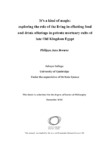Browne, Philippa
Food and drink were vital for post mortem existence in Ancient Egypt, and the presentation of these by the living to the dead at the tomb formed a key part of the mortuary cult. Egyptological scholarship commonly proposes that once the cult ceased, and the temporary, perishable offerings along with it, a permanent, ‘magical’ supply was provided via image, text, and object representations of sustenance in the tomb. This study examines these ‘modes’ through which offerings were present and presented. Complementary theoretical frameworks are employed in case studies that analyse illustrative examples of the offering related decorations, installations, and objects from a number of elite late Old Kingdom tombs (c.2492 2181 BCE) at Saqqara. These demonstrate that tomb design incorporated different modes to communicate salient information about the cult to the living: it took into account their varying literacy and resource levels as did the different modes of offerings that they could use to sustain the dead. Modes were therefore deployed to facilitate interaction between the two parties. The conclusion is that magic (Egyptian ḥkꜢ/Ꜣḫw) was involved in effecting offerings of all kinds, but that the living played an indispensable role in channelling this force to endow offerings with the capacity to sustain the dead, rather than such agency being inherent. Ongoing cult participation both ensured the effectiveness of the offerings in the tomb, and articulated the social relationships between the worlds of the living and dead. The study results in a more nuanced understanding of the mortuary cult, explicating the significance of offerings in the articulation of relationships between the living and dead, and establishing the notion of reciprocity as a driving factor. Finally, it suggests that to focus solely on offerings as ‘magical/permanent’ or ‘real/temporary’ is to obscure the cult as a social process.Keywords
Old Kingdom, Ancient Egypt, Mortuary cult, Offerings, Agency, MagicSponsorship
Arts and Humanities Research CouncilFunder references
AHRC (1651842)AHRC (1651842)Identifiers
This record's DOI: https://doi.org/10.17863/CAM.59584Rights
All rights reserved, All rights reserved, All rights reserved, All rights reservedLicence:http://www.rioxx.net/licenses/all-rights-reservedAdvisors
Spence, KateDate
2019-12-24Awarding Institution
University of CambridgeQualification
Doctor of Philosophy (PhD)Type
Thesis










 Stumble It!
Stumble It!

No comments:
Post a Comment